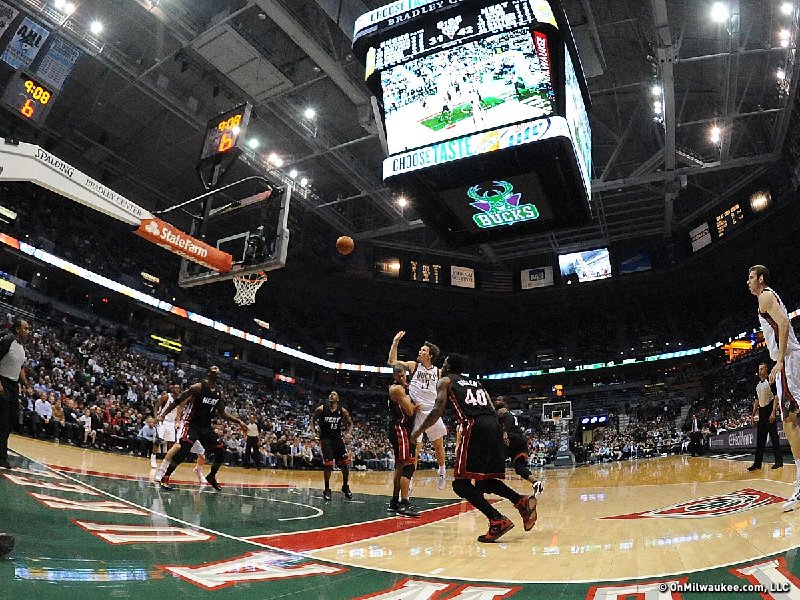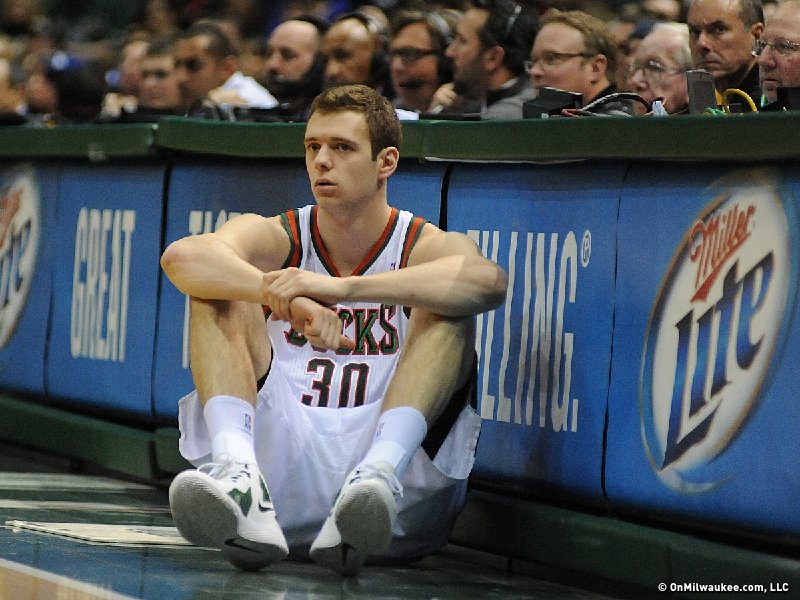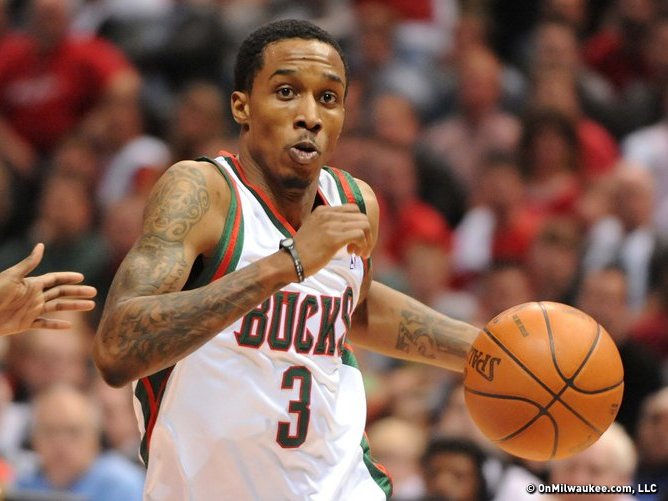It's a bad idea. It's fiscally irresponsible. School budgets are being cut and yet you want to build a palace for millionaires? Make 'em pay for it themselves! It's an empty threat – they'll never leave! Besides, they've been awful for so many years anyway, so what's the difference if they do leave?
I'm of course talking about the Milwaukee Bucks, right?
Nope. At least not entirely.
All of the arguments being bandied about regarding the Bucks might sound familiar because they were the exact same arguments the hand-wringing naysayers said about the construction of Miller Park in the mid-1990's.
Go ahead. Read the first paragraph again. You will instantly be transported back to 1995. The fight to finally put shovel in dirt was long and protracted; ugly and intense. Even after the ballpark's Nov. 9, 1996 groundbreaking there were still some that tried to kill the project and drive the Brewers out of town, most notably former State Sen. Joe Wineke (D-Verona). While Wineke never said that he did not care whether or not the Brewers remained in town, his posturing and stonewalling nearly prevented the passing of the bill in Oct. 1995 in the first place.
Every politician wants to make it clear to their constituents that they are fiscally responsible with the taxpayer's money. This should be admired. However, you won't be able to find many people opposed to Miller Park today considering the sold-out crowds and division champions we all witnessed this past summer.
This brings me to the increasingly-fragile Milwaukee Bucks.
You cannot pin anything on one loss. That would be absurd. However, the Bucks, in this perilous time are losing what casual fans they have in their corner by failing on the court.
Thursday night's 103-100 loss at Sacramento has become a microcosm of where the Bucks are right now. Every time you think they do something good they blow it. Just look at all of last season.
Getting back to Thursday, leading by 21 points at halftime and 14 after three quarters, Scott Skiles crew forgot how to defend and rebound, falling yet again on their current West Coast road trip.
Monday night in Denver, the Bucks led by 9 points in the second half, but again fell apart in the fourth quarter, losing 91-86. Opening night, Milwaukee led by as many as 14 at Charlotte before losing 96-95 to the Bobcats, one of the few teams in the Eastern Conference that were actually worse than the injury-riddled, zero-cohesion Bucks last year.
Yes, it is early, but the returns in a shortened season have not been promising.
The Bucks only two wins have both come at home against Washington and Minnesota, who are a combined 2-10 this season and were a combined 84 games under .500 last year.
That's pathetic.
Coming up, Milwaukee has road games against the much improved Clippers and the Suns. Los Angeles is in first place and the Bucks losing streak in Phoenix dates back to the Reagan Administration (that isn't an exaggeration, by the way).
The problem with the Bucks right now on the court only magnifies the intense battle they are going to face when it comes time to stop speaking in abstracts and actually put forth a plan to build a new arena. To show urgency, you need to demonstrate a public desire for such a venue. Without wins, playoff appearances, and most importantly, hope, the public sentiment for such a capital expenditure will be solely limited to rabid sports fans.
Unfortunately, it is not the rabid fans that you need to court. It's the casual fans that need to be wooed. And right now, this team's pitiful displays of basketball ineptitude are turning the masses off.
To those who think the bluster of a new building is just a lot of hot air, hear me loudly and clearly: Without a new facility in the next 5-8 years, the Milwaukee Bucks will no longer be here.
While the arguments against construction of a new building are virtually the same as with County Stadium, the economic times are certainly different. In 1996, the dot-com boom helped swell an economy that was more favorable to investing in capital improvement projects. Since the Sept. 2008 Wall Street collapse, discretionary spending has been put on hold by most companies and families.
The other argument against construction is that most of us remember when the Bradley Center opened. It doesn't aesthetically look all that bad, even if it compares unfavorably to it's brethren around the NBA.
However, facts are facts. When the NBA season began, the Bradley Center was tied with the Detroit Pistons' Palace at Auburn Hills and the Sacramento Kings' Power Balance Pavilion for the third-oldest facility in the league. The two buildings that are older, Oracle Arena in Oakland (1966) and Madison Square Garden (1968) have either had or are undergoing a complete refurbishing.
In Sacramento, where the Bucks imploded Thursday night, the Kings are on life support, with the looming threat of moving to Anaheim being held over the heads of their fans this past off season. That threat still remains absent a replacement for their arena that opened at the same time Milwaukee's did.
In Seattle, fans never thought that the Sonics would really move. They had just spent almost $75 million in renovations less than 15 years earlier, but Key Arena still lacked the amenities places like the newer Staples Center and Canseco Fieldhouse had. Fans were warned that if a new arena wasn't going to be built, the franchise's new owners would take their budding superstar, Kevin Durant, and move them to greener pastures. After 41 years and an NBA championship, the Sonics became the Oklahoma City Thunder because there was a community thirsty for the prestige of professional sports and the nearly brand-new Ford Center ready to be called home.
Currently, there are new arenas in Kansas City, Omaha, and Louisville that are more in line with today's NBA standards than the Bradley Center. There are plans being drawn for NBA style arenas in Baltimore, Las Vegas, and Virginia Beach.
In Milwaukee, the Bradley Center isn't thought of as being as badly off as County Stadium was. To that argument, that's true. County Stadium was a crumbling ruin and was falling apart right before our eyes. The Bradley Center still attracts big-name concerts and still features an elegant entrance to the building. There is a sense of class the Bradley Center has that County Stadium never did. For the most part, the seats are comfortable (if a bit on cramped side). Nothing about the building screams that it is an obsolete relic.
The problem is that it is, at least as far as the economics of the NBA are concerned. Outside of the new scoreboard, very little has been spent on the building since its Oct. 1988 opening. It ranks at the very bottom of the list for producing revenue among other NBA arenas. Today's NBA buildings have larger suites, year-round restaurants, retail facilities, and in many cases, complete entertainment districts surrounding them.
In Los Angeles, the Staples Center is the centerpiece of the LA Live district which includes the Nokia Theatre, the Grammy Museum, and dozens of retails shops, restaurants, and night clubs. In Dallas, the American Airlines Center is attached to an entertainment venue that includes the storefront news studio of the city's ABC television affiliate. In Phoenix, the U.S. Airways Center features a Lambeau Field-like atrium that is open to the public on non-game days where you can shop or eat.
The Bradley Center is a facility that in its entirety is asleep when there isn't a game or concert.
The time to build is now. Construction costs rise every year, and we now know what mistakes to not repeat in the building process.
Just as public funds have built arenas and stadiums all over the country (including Miller Park and Lambeau Field); the Bucks need help from the public to help build a new facility. The concept isn't a new one. Businesses are given numerous tax breaks and facilities to entice them to either stay or relocate. Businesses create jobs. Jobs create communities. The more jobs there are, the healthier that community is.
Just as roads, zoos, parks, and museums add value to a community, so do professional sports. Miller Park was a community investment, so would be a new arena for the Bucks. Tens of millions will enjoy going to games during the building's lifespan, and it helps keep our community "big league."
Recently, my colleague here at OnMilwaukee.com, Dave Begel, put it best last week when he opined: "Major league is major league. Everything else isn't."
There is no replacement for the Bucks. Once they are gone, there is nothing that will fill that void. Nothing.
Those that oppose a new arena thinking that the NHL is ready to move in the Bradley Center (a hockey building by design) are fooling themselves. The thought that any NHL team would move into a 23-year old building is as laughable as expecting Prince Fielder to fit into size 30 pants. The same constraints that are hindering the business of the NBA plague the NHL, only to a lesser degree. For now.
To those that oppose a new arena, I ask you to heed two examples. The example of Seattle and the example of the Brewers. The former yearns for a chance to have a do-over, while the latter is the best example anyone can come up with for forward-thinking leadership on a community investment that millions will enjoy for generations.
Watching charcoal smoke billow over the Miller Park parking lots this past summer it is hard to imagine that there were actually well-intentioned people that didn't want it built.
But that smoke represents so many things: Friends that don't see each other nearly enough catching up on their lives; fathers and sons bonding over a brat and a game of bags; kids connecting with their sports idols; a community coming together as one despite socioeconomic barriers.
While there wouldn't be tailgate smoke before a Bucks games, the bonds of sports and society remains. Milwaukee needs the Bucks, even if our elected leaders are loath to admit it for fear of losing reelection. But trying times call for bold leadership. Milwaukee is major league in so many ways. To allow the Bucks to move would knock our collective status down considerably.
The time to act is now.
Doug Russell has been covering Milwaukee and Wisconsin sports for over 20 years on radio, television, magazines, and now at OnMilwaukee.com.
Over the course of his career, the Edward R. Murrow Award winner and Emmy nominee has covered the Packers in Super Bowls XXXI, XXXII and XLV, traveled to Pasadena with the Badgers for Rose Bowls, been to the Final Four with Marquette, and saw first-hand the entire Brewers playoff runs in 2008 and 2011. Doug has also covered The Masters, several PGA Championships, MLB All-Star Games, and Kentucky Derbys; the Davis Cup, the U.S. Open, and the Sugar Bowl, along with NCAA football and basketball conference championships, and for that matter just about anything else that involves a field (or court, or rink) of play.
Doug was a sports reporter and host at WTMJ-AM radio from 1996-2000, before taking his radio skills to national syndication at Sporting News Radio from 2000-2007. From 2007-2011, he hosted his own morning radio sports show back here in Milwaukee, before returning to the national scene at Yahoo! Sports Radio last July. Doug's written work has also been featured in The Sporting News, Milwaukee Magazine, Inside Wisconsin Sports, and Brewers GameDay.
Doug and his wife, Erika, split their time between their residences in Pewaukee and Houston, TX.







